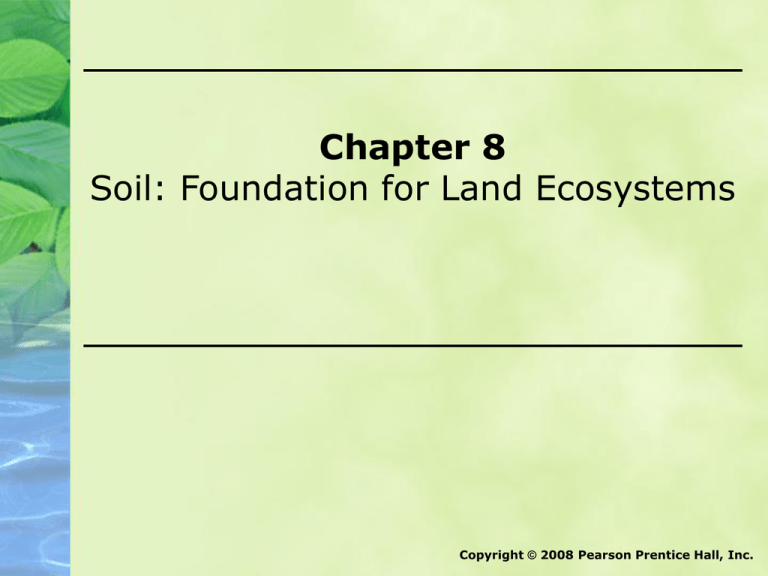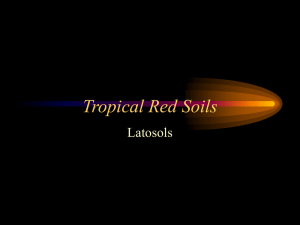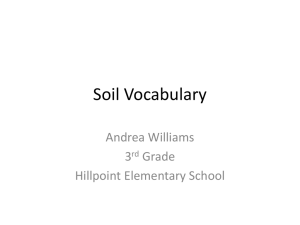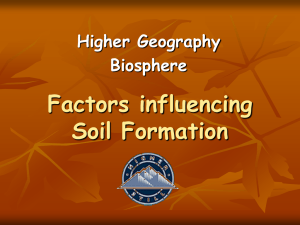
Chapter 8
Soil: Foundation for Land Ecosystems
Copyright © 2008 Pearson Prentice Hall, Inc.
8.1 - Global Trend: Where Did
All the Farms Go?
• Poor farming practices = loss of soils
and farmland.
• Erosion
• Salinization
• Development in United States = loss of
1.4 million acres of farmland per year.
Why a Study of Soil Is
Important
• 90% of the world’s food comes from
land-based agriculture.
• Maintenance of soil is the cornerstone
of sustainable civilizations.
• Simply stated, it is the “foundation” of
terrestrial life.
Soil Ecosystem: Distinguishing
Characteristics – Part 1
• Slow rate of nutrient and energy
transfer
• Few months: tropical rainforest
• Few years: temperate forests
• Different textures demand different
adaptations, e.g., worms and pocket
gophers
• Near total reliance on decomposers
Soil Ecosystem: Distinguishing
Characteristics – Part 2
• Exclusive use of detritus for energy and
nutrients
• Extreme susceptibility to disturbance
and slow recovery times
Topsoil Formation
Soil Formation and Nutrient
Uptake
Soil
Formation
(click to view animation)
Soil Formation
Soil Profile
Soil Particles
• Sand - largest, can see with naked eye,
2 mm to 0.02 mm
• Silt - medium, 0.02 mm to 0.002 mm
• Clay - very fine, smaller than 0.002 mm
Soil Texture
• Soil texture refers to the percentage of
each type of particle found in the soil.
• Loam soil is approximately 40% sand,
40% silt, and 20% clay.
Soil Texture Triangle
Soil Formation and Nutrient
Uptake
Nutrient
Availability
(click to view animation)
Nutrient Availability
Water Transport by Transpiration
Plant-soil-water Relationships
Productive Soil
• Good supply of nutrients and nutrientholding capacity (limits leaching)
• Infiltration, good water-holding capacity,
resists evaporative water loss
• Porous structure for aeration (avoid
compaction)
• Near-neutral pH
• Low salt content
The Soil Community: The 5%
Organic Component
Humus
• Partly decomposed organic matter
• High capacity for holding water and
nutrients
• Typically found in O horizon
Humus and Development of
Soil Structure
8.2 - The Importance of
Humus to Topsoil
GLADSOD
• Global assessment of soil degradation
map (1987-1990)
• No global data on soils existed at the
time
• Informal surveys (not very accurate)
• Very few actual samples collected
• GLADSOD estimated that
desertification had occurred on 20%
of the land worldwide
• Current estimates closer to 10%
Erosion: Wind or Water
• Splash erosion: impact of falling
raindrops breaks up the clumpy
structure of topsoil
• Sheet erosion: running water carries off
the fine particles on the soil surface
• Gully erosion: water volume and
velocity carries away large quantities of
soil causing gullies (next slide)
Desertification
• Formation and expansion of degraded
areas of soil and vegetation cover in
arid, semiarid, and seasonally dry
areas, caused by climatic variations
and human activities.
Formation of Desert
Pavement
Formation of Desert Pavement
Dryland Areas
• Cover one-third of Earth’s land area
• Defined by precipitation not
temperature
• United Nations Convention to Combat
Desertification (UNCCD)
• Fund projects to reverse land degradation
• In 2003, $500 million available in grants to
fund projects
Desertification
Three Major Practices That
Expose Soil to Erosion
• Overcultivation - planting crops/farming
• Overgrazing - from livestock
• Deforestation - cleared for farming or
construction
Causes of Soil Degradation
Alternative Farming Practices
That Conserve Soil
• No-till planting - kill weeds chemically,
then plant and add fertilizer
• Contour farming - right angle to slope
• Shelter belts - trees around fields
• Dry land farming – minimize irrigation
• Crop Rotation – especially legume vs.
non-legume
Contour Farming
Shelterbelts
Irrigation
• Flood irrigation (next slide)
• Center-pivot irrigation (Chapter 7)
• Can extract as much as 10,000
gallons/minute
• Irrigated lands
• 67 million acres or one-fifth of all cultivated
crop land in the United States
• 667 million acres worldwide, a 35%
increase over the past 30 years
Flood Irrigation
Salinization
• A process of distilling out dissolved
salts in irrigated water and leaving it on
the land
• A form of desertification since land is
rendered useless
• Worldwide an estimated 3.7 million
acres of agricultural land are lost
annually to salinization and
waterlogging
8.3 - Public Policy and Soils
• Soil and Water Conservation Act of
1977 - aid landowners and users;
evaluate U.S. soils, water, and related
resources
• Food Security Act (1985) “Swampbuster” - discouraged
conversion of wetlands
• Subsidies
• Numerous Farm Bills
Conserving the Soil
•
•
•
•
•
Cover the soil - cover crop
Minimal or zero tillage
Mulch for nutrients
Maximize biomass production
Maximize biodiversity










